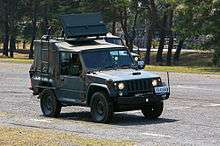Type 88 Surface-to-Ship Missile
| Type 88 Surface-to-Ship Missile, SSM-1 | |
|---|---|
 | |
| Type | Anti-ship cruise missile |
| Place of origin | Japan |
| Service history | |
| In service | 1988 |
| Production history | |
| Manufacturer | Mitsubishi Heavy Industries |
| Specifications | |
| Weight | 661 kg (1,457 lb) |
| Length | 5.08 m (16.7 ft) |
| Diameter | 350 mm (13.8 in) |
| Warhead | HE |
| Warhead weight | 225 kg (496 lb) |
|
| |
| Engine | Mitsubishi TJM-2 turbojet + 2 solid rocket boosters[1] |
Operational range | 180 km (97 nmi; 112 mi) |
| Flight altitude | 5-6 m |
| Speed | Mach 1.5 |
Guidance system | Inertial guidance and terminal active radar homing |
Launch platform | Truck |
The Type 88 Surface-to-Ship Missile (88式地対艦誘導弾, SSM-1) is a truck-mounted anti-ship missile developed by Japan's Mitsubishi Heavy Industries in the late 1980s. It is a land-based version of the air-launched Type 80 (ASM-1) missile; in turn it was developed into the ship-launched Type 90 (SSM-1B) missile. The Japan Ground Self-Defense Force bought 54[1] transporter erector launchers, each carrying six Type 88 missiles, for use as coastal batteries. With a range of 180 km (97 nmi), high subsonic speed and 225 kg (496 lb) warhead, it is similar to the US Harpoon missile.
In 2015, an upgrade of the Type 88 became operational called the Type 12 . The Type 12 features INS with mid-course GPS guidance and better precision due to enhanced contour/terrain matching and target discrimination capabilities. The weapon is networked, where initial and mid-course targeting can be provided by other platforms, and also boasts shorter reload times, reduced lifecycle costs, and a range of 124 mi (108 nmi; 200 km).[2][3]
Overview

The basic configuration composes the same launcher vehicles and loader vehicles (6 SSM-1), some radar vehicles, fire control systems, and a command control system.
Usually, the SSM-1 is launched from within 100 km (62 mi) of the coast.
See also
References
- 1 2 Wertheim, Eric (2007). The Naval Institute Guide to Combat Fleets of the World: Their Ships, Aircraft, and Systems. Naval Institute Press. p. 374. ISBN 9781591149552.
- ↑ China Reacts to Japanese Anti-Ship Missile Positioning - News.USNI.org, 18 June 2014
- ↑ Japan Plans To Deploy Missiles To Strategic Island Near Taiwan - Foxtrotaplha.Jalopnik.com, 19 May 2015
| Wikimedia Commons has media related to Type88 (SSM). |